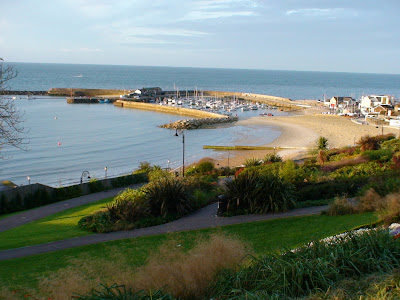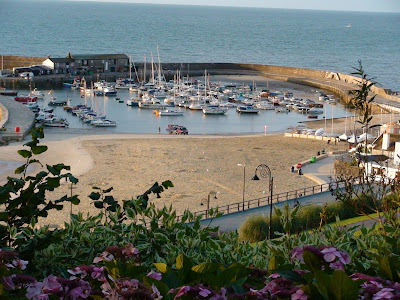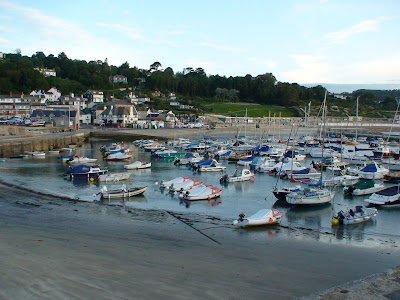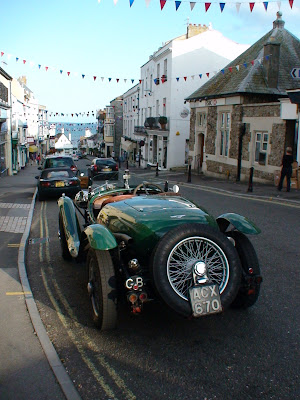SUBLYME
We dropped down into Lyme Regis as though suspended from a Bosun’s chair, our little car restrained by the brake as we tumbled down Broad Street to the sea. Lyme – nobody uses the Royally conferred ‘Regis’, which was given way back in 1284 – was to us, a bit like a fabled relative, one whom you have heard about, but never met, yet their exploits are well known. It had so many coat-tails, ‘The Pearl of Dorset’, the ‘Capital of the Jurassic Coast’, ‘Jane Austin’s inspiring seaside town’, a favourite place for Beatrix Potter, Tolkien, Tennyson and Turner. And oh yes, that Johnny-come-lately, Mr Fowles. You don’t remember him? Get out of here! Everyone read The French Lieutenant’s Woman and those that didn’t read it, saw the film with a caped Meryl Streep standing windswept on the Cobb, the curling granite break-water, staring into the bleak grey skies, longing for the return of her man! See, I knew that you had ‘been there' before!

Little Lyme was first mentioned in the Doomsday Book, the Norman ledger of all property in England, in 1086, so it has a solid little pedigree. From the 13th Century until the mid 19th Century, it was a major port of Southern England, a centre for fishing and ship-building, and often the first landfall for ships from France. News of Nelson’s great victory at Trafalgar, came ashore at Lyme, so too the news of the defeat of Napoleon at Waterloo. West Indiamen full of sugar and rum, often filled Lyme’s harbour although today it is hard to imagine a half-decent lifeboat anchoring there. Indeed, it was size that killed Lyme's sea-faring as after 1850, its made-for-the-movies port, was simply too small for the bigger ships. Lucky us, for we can still see what it was like then. Imagine if those Lymies had access to a dredge or two and a boulder quarry, why Lyme would be like Portsmouth or Southampton! And, I am sure, there is no way that John Fowles would have put his woman on the pier if the, setting hadn’t remained riveted in ‘the olden days’!
We found accommodation in the Rock Inn, the last in town we were told, and when we saw it, we believed it. The Inn stood on the water’s edge, whitewashed and prominent, like a thumb held aloft. We entered through the bar, the warm bouquet of frying chips greeting us, Aston Villa on the tele, and the pint-jar crowd eyeing us as though we were horse-apples. A callow youth took us up two flights of burgundy carpeted stairs, here and there a towel or bloomers strung over the balustrade, a large key like that to open a pirate chest, was inserted in the door, and there was a double bed and a walnut chest of drawers which I am sure were mentioned in the Doomsday book. The floor would have been challenging to Eddie the Eagle, but out of the window there was a fine view of the Jurassic Coast, and you could see to Portland Bill. I dare say that there was still a vestige of a more glamorous past when sea captains might have sat on this very bed, unscrewing their peg leg and hanging their hook on a hooker. But like Joan Rivers, that glamour had receded a long time ago. The Rock Inn had made an attempt to tart up a bit, and the modern shower was a bit like having some botox while the rest of the body continued to decay. Mind you, when we came home later that night and tried the Dr Who-like cubicle, only boiling water emerged, so we settled for a bird-bath. The bed too, was like a sago pudding, lumpy and soft, and all for sixty-five quid. Piracy still rules in Lyme.

With a little daylight left, we set out for the iconic Cobb, and walked along a pleasant scimitar of pebbles upon which people sat on towels, and then dashed back to those Victorian multi-toned beach houses which give so much colour to the ‘typical English seaside’. Along the strip there were the usual array of shops selling ice-creams, fudge (The double-clotted cream was to die for), fish and chips and burgers, a Punch and Judy theatre, and a wheezing, popping, clanging amusement parlour. People strolled along the promenade in that easy sea-side manner, gazing at the wrinkly sea, and then to the looming cliffs with green pasture on top like a toupee. Occasionally bits of the cliff fell into the sea and then palaeontologists licked their lips and got out their silver hammers, and went looking for fossils. Ammonites, those sea-shell like fossils that look like a caterpillar curled up are prominent and many shops in Lyme sell fossils. Even the lighting stanchions all have a pleasing ammonite design, looking rather like upturned French Horns. The area has a United Nations World Heritage listing and the Lymies are rightly proud of their historic and pleasing town.
We wandered onto the Cobb and my wife did a Streep, for the keen wind scattered her careful grooming, and brought a tear to her eyes although sadly, the waves merely licked at the stonework with none of the 'movie spume'. We climbed down the dicky stone steps and into the lee of the cradling stone arm sheltering a mosquito fleet of fisher-boats. The safe harbour looked little changed through the centuries. We strolled back along a sandy cove, which met the pebbles, and as the light withdrew, we had a pleasant meal overlooking the beach and the brooding cliffs beyond. And then, to accompany our feasting, there came a phalanx of Morris Men, jolly hockey sticks clacking in their dance, calf bells jangling, hats a kilter, and then hankies fluttering like bunting in a less violent dance. A small crowd clapped, we among them, and we threw our pound coins into the waved bucket, a veritable cabaret act to accompany our haddock and chips. It was all so convivial, and quaintly English, and in merriment on the way home to the Rock Inn, I broke into an impromptu We do like to be beside the seaside in my best George Formby voice. All that was missing was the donkey ride along the beach!

The next morning, while Lyme still slept, I walked through the town's quiet, picturesque, streets, with lovely old stone buildings quietly watching me go. A coastal sewerage system was cleverly disguised as a castle keep, and beside a tiny rivulet stood an old mill. Seagulls flew top cover as I puffed my way up Broad Street, past a manor house where the Prime Ministers' Pitt had spent seaside holidays, past bookshops and comely curiosity shops selling striped lighthouses and wind-jammers in full sail. Half way up I turned around and looked down the telescoped view between the buildings, to a Victorian pedestal clock, the oily sea and the cliffs beyond. In the stillness it was decidedly beautiful. I passed by two hotels, the Alexander quite luxurious, with superb views of Lyme Bay, with Bentleys and Jaguars in the fore-court. Here, we should have stayed, but then again our sixty-five quid would hardly have purchased the hors d'ouvres.
I sat in a park opened by the Princess Royal, and in one part, named after Jane Austin. It would not take much Persuasion to have me linger longer in Lyme, and I watched its little harbour come to life, and people start to walk their dogs. Nearly fifty percent of the citizens of Lyme, are retirees, and I could see why they had chosen this place to see out their lives. Lyme is sublime. If only we had more time!

Winfred Peppinck is the Tales of the Traveling Editor for Wandering Educators.
